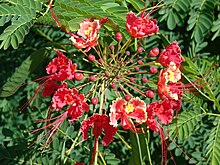Caesalpinia
Appearance
| Caesalpinia | |
|---|---|

| |
| Caesalpinia pulcherrima | |
| Scientific classification | |
| Kingdom: | Plantae |
| Clade: | Tracheophytes |
| Clade: | Angiosperms |
| Clade: | Eudicots |
| Clade: | Rosids |
| Order: | Fabales |
| Family: | Fabaceae |
| Subfamily: | Caesalpinioideae |
| Tribe: | Caesalpinieae |
| Genus: | Caesalpinia Plum. ex L. |
| Type species | |
| Caesalpinia brasiliensis L.[1]
| |
| Species | |
|
See text | |
| Synonyms[2] | |
| |
Caesalpinia is a genus of flowering plants in the family Fabaceae. Historically, membership within the genus has been highly variable, with different publications including anywhere from 70 to 165 species, depending largely on the inclusion or exclusion of species alternately listed under genera such as Hoffmannseggia. It contains tropical or subtropical woody plants. The generic name honours the botanist, physician, and philosopher Andrea Cesalpino (1519–1603).[3]
The name Caesalpinaceae at family level, or Caesalpinioideae at the level of subfamily, is based on this generic name.
Species
- Caesalpinia acapulcensis Standl.
- Caesalpinia anacantha Urb.
- Caesalpinia bahamensis Lam.
- Caesalpinia barahonensis Urb.
- Caesalpinia brasiliensis L.
- Caesalpinia cassioides Willd. 1809
- Caesalpinia erianthera Chiov.
- Caesalpinia monensis Britton—black nicker
- Caesalpinia nipensis Urb.
- Caesalpinia pulcherrima (L. 1753) Sw. 1791—Pride of Barbados, yellow peacock
- Caesalpinia secundiflora Urb.
- Caesalpinia delphinensis Du Puy & Rabev.
- Caesalpinia homblei R. Wilczek
- Caesalpinia minax Hance
- Caesalpinia murifructa Gillis & Proctor
- Caesalpinia solomonensis Hattink
- Caesalpinia volkensii Harms
- Caesalpinia caesia Handel-Mazzetti
- Caesalpinia chinensis Roxb.
- Caesalpinia crista L. emend. Dandy & Exell—gray nicker
- Caesalpinia elliptifolia S. J. Li, Z. Y. Chen & D. X. Zhang
- Caesalpinia hypoglauca Chun & How
- Caesalpinia kwangtungensis Merr.
- Caesalpinia laevigata Perr.
- Caesalpinia magnifoliolata Metcalf
- Caesalpinia nuga (L.) Ait.
- Caesalpinia paniculata (Lam.) Roxb.
- Caesalpinia rhombifolia J. E. Vidal
- Caesalpinia scandens Heyne ex Roth
- Caesalpinia szechuanensis Craib
- Caesalpinia vernalis Champion
- Caesalpinia yunnanensis S. J. Li, D. X. Zhang & Z. Y. Chen
Uses
Some species are grown for their ornamental flowers.
References
- ^ "Caesalpinia L." TROPICOS. Missouri Botanical Garden. Retrieved 2009-10-19.
- ^ "Genus: Caesalpinia L." Germplasm Resources Information Network. United States Department of Agriculture. 2007-04-03. Archived from the original on 2009-05-06. Retrieved 2010-12-03.
- ^ Gledhill, David (2008). The Names of Plants (4th ed.). Cambridge University Press. p. 83. ISBN 978-0-521-86645-3.
External links
 Media related to Caesalpinia at Wikimedia Commons
Media related to Caesalpinia at Wikimedia Commons Data related to Caesalpinia at Wikispecies
Data related to Caesalpinia at Wikispecies- USDA PLANTS Profile
